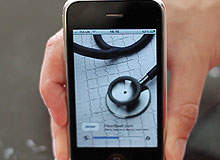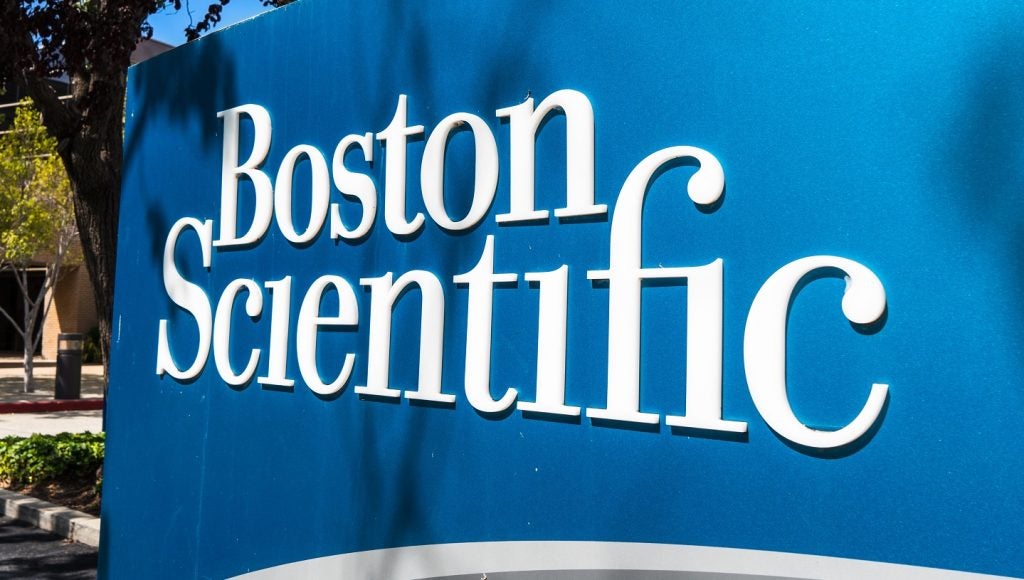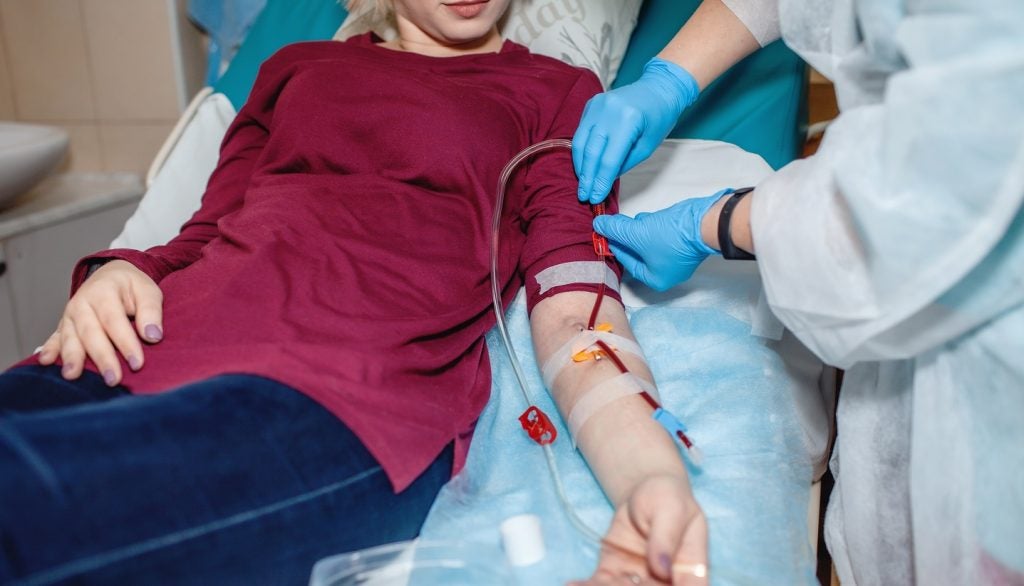
1. Orthopaedic stem cell concentrator
Field: Stem cell regeneration
Tissue engineering strategies seek to harness the regenerative potential of stem (or progenitor) cells to replace tissue that has been lost or damaged through injury or disease. In the context of orthopaedics, applications include spinal fusion, bone stock replacement following trauma, excision of neoplastic or infected bone for revision joint replacement surgery or for the treatment of arthritides and tendinopathies.
This novel device, developed by the University of Southampton Bone and Joint Research Group in collaboration with Smith & Nephew, uses an innovative, acoustic cell separation technology developed and patented in 2007 by Smith & Nephew at its research centre in York. The acoustic wave facilitates filtration of the human bone marrow sample through filters of specified thickness, pore size and density, enabling it to rapidly enrich the active portion of bone marrow in a timeframe and scale applicable to the operating theatre. The end result is a standalone, single-use, fully disposable filtration device that can enrich osteoprogenitor cells from human bone marrow aspirate for immediate clinical use.
As the systems already on the market cannot be used within the sterile environment of an operating theatre, the development of this device marks a step change in cell enrichment. It will significantly affect three orthopaedic market segments: trauma, spinal fusion and cartilage focal defect. Moreover, once the initial product and applications have been established, there will also be opportunities in other markets, such as soft tissue repair, cardiovascular and veterinary medicine. In the meantime, the ability of the device to benefit end-users is clear: it is set to reduce operating time, save money and resources, and improve patient care.
2. Acrobot surgical systems
Field: Robotics
See Also:
Imperial College London spin-out Acrobot, a medical device company specialising in computer-assisted orthopaedic surgery, offers a unique non-optical and non-electromagnetic navigation system that uses mechanical tracking. This means that there are no interference issues (usually associated with electromagnetic tracking) and no line-of-sight issues (as there are with optical tracking). It is known as the Acrobot Navigator.
How well do you really know your competitors?
Access the most comprehensive Company Profiles on the market, powered by GlobalData. Save hours of research. Gain competitive edge.

Thank you!
Your download email will arrive shortly
Not ready to buy yet? Download a free sample
We are confident about the unique quality of our Company Profiles. However, we want you to make the most beneficial decision for your business, so we offer a free sample that you can download by submitting the below form
By GlobalDataAcrobot was a development organisation for several years following its spin out in 1999, surviving on grant income until venture capital funding was raised in mid-2007. Using this influx of capital, technology was turned into products, which were then put on the market later in the year. Although the UK-based company initially focused on surgical navigation in orthopaedics, its focus has more recently moved to robotics in orthopaedics, a growing area in the medical device industry.
Acrobot was acquired by Stanmore Implants, an orthopaedic implant company, in August 2010. Its latest product, the Acrobot Sculptor, is set to hit the market in 2011. A hands-on robotic system, which uses ‘active constraint’ technology to prevent a surgeon accidentally moving outside a specified area, Acrobot Sculptor may be one of the products to bring about a shift change in surgical techniques.
3. Syncardia temporary total artificial heart
Field: implantation
Although the Syncardia artificial heart has been around for several years, the life-saving device continues to make waves as it develops. The device is the result of decades of collaboration between hundreds of scientists, physicians, engineers and students. Its first use was documented in 1957 when a heart was implanted into a dog; it lived for 90 minutes.
Today the temporary total artificial heart is approved as a bridge to human heart transplant for people dying from end-stage biventricular failure. It is the only device that provides immediate, safe blood flow of up to 9.5l/min through both ventricles. Syncardia has implanted more than 850 total artificial hearts so far, which accounts for in excess of 200 patient years on the device. Over the next year, the company expects use of the device to more than double, as its Freedom driver goes through its US Food and Drug Administration investigational device exemption clinical study.
Looking to the future, the development of a permanent heart using new, longer lasting materials is set to continue over the next year, as well as the development of a 50cc heart for adults of smaller stature.
4. AccuVein AV300
Field: Electronics
Launched in May 2009, the AccuVein AV300 is the world’s first handheld, non-contact vein illumination device that helps healthcare professionals to locate hard-to-find veins. Although vein illumination has been around for some time, early devices were essentially bright flashlights. While later technologies used infrared imaging to project the vein pattern onto the skin, they were too large and expensive for extensive deployment.
The AV300, however, was developed with the weaknesses of previous devices in mind, meaning the company had to rethink the basic approach to vein location, which involved extensive human factor studies and a focus on the visual appearance and user interface.
Venipuncture is the most common invasive medical procedure – with 2.7 million performed every day in the US alone – so there is little doubt that the AV300 has a bright future. Already deployed in more than 300 hospitals in the US and available in more than 50 countries around the world, the company believes it has only scratched the surface of the technology’s potential. Early adopters have already written vein illumination into their standard of care, and AccuVein is working with its users to help them do the same.
5. Baxano iO-Flex system
Field: Surgery
The Baxano iO-Flex system is an advancement in surgical technology for central lateral recess and foraminal lumbar stenosis. It uses thin, flexible instruments through an open exposure or a minimally invasive tube to provide precision lumbar decompression from the inside out.
This ‘over-the-wire’ approach allows surgeons to address targeted impinging tissue with a non-implant direct decompression, while preserving facet joint integrity. Up to four nerve roots may be decompressed through a single-point access using this system.
The first product of its kind, the iO-Flex system fills what the company sees as a huge unmet need for spine surgeons. Some 70,000 lumbar spinal fusion procedures for lumbar spinal stenosis are performed in the US annually, and inadequate treatment of foraminal stenosis is the most common structural cause of failed back surgery syndrome.
This new product is minimally invasive and has seen a huge amount of interest from physicians and patients who can really benefit from the use of the iO-Flex System in their lumbar decompression surgical procedures.
6. Magneto Optical Technology (MOT) device
Field: Diagnostics
Based on the use of the magneto-optic effect to diagnose malaria, the MOT device achieves this by sensing the changes wrought by infecting malarial parasites on the oxygen-carrying haemoglobin molecules contained in red blood cells. It was developed during a €1.4m, seven-partner, four-year project led by the University of Exeter and funded by the European Commission, and will find application in malaria-endemic regions of the world.
In these areas, the use of antigen-detecting rapid diagnostic tests is state-of-the-art for remote location diagnosis, but these have inherent problems, which the MOT device avoids. It immediately affords rapid volumetric examination in a minimally-invasive finger prick format, and there is also potential of extension to true non-invasive operation by optically accessing the blood supply below the fingernail.
Aimed at modestly skilled health workers, the MOT device is a new, unconventional detection route; a rapid departure from current reagent-dependent techniques. It boasts significant advantages in terms of sensitivity, cost-per-test and speed of diagnosis. If adopted, it could lead to cheap and reliable screening programmes in areas such as sub-Saharan Africa. So far, the device has only been tested in a lab, but has already been shortlisted for an IET Innovation award.
7. ResMed S9 Series
Field: Respiratory equipment
A new cutting-edge sleep apnoea therapy platform called the S9 Series was launched in Europe in early 2010 by ResMed, a manufacturer and distributor of sleep and respiratory medical equipment. Sleep apnoea is one of the more common, yet highly undiagnosed, sleep disorders, which can cause the sufferer to stop breathing in the middle of the night.
The most effective treatment for this is continuous positive airway pressure therapy, throughout which air is pressurised by a small device and delivered to the patient’s airway through a mask that fits over the nose, or over the nose and mouth. The pressurised air keeps the upper airway open.
This recently launched device, developed by R&D teams across the globe over three years, has been billed as a revolution in positive airway pressure therapy, and aims to contribute to improved patient comfort, compliance and outcomes.
Air is delivered quietly and comfortably at the precise temperature and humidity that the sleeping patient, provider and physician have set. The company has experienced strong patient support for the product so far, largely due to the fact that it provides more comfortable treatment and is easier to use than competing technologies.
8. Medibord oncology couch top
Field: Material innovation
UK designer and manufacturer Medibord has developed a non-conductive, flat couch top and overlay material, initially for use with MRI scanners. The product was launched in November 2009 after 12 months in development, and has subsequently won two awards for medical innovation.
Created in conjunction with Nottingham University Hospitals NHS Trust (NUH), the couch top – also called Medibord – came into being because of market demand for a product that enables clinicians to combine MRI and CT scans for use in radiotherapy planning.
As Medibord can be custom-shaped, NUH was able to retrofit bespoke flat couch tops to its MRI scanners and position patients with repeated precision to facilitate CT and MR image fusion. This enabled oncologists to achieve their long-term goal of precisely outlining prostate cancer patient scans.
It is estimated that there were 20,000 operational MRI scanners in the world in 2008, and, this number is set to increase. As the demand for diagnostic imaging grows, the number of applications for Medibord’s innovative couch top is expected to do the same.
9. BD Micro-Fine + 4mm pen needle
Field: Injection therapy
Medical technology company BD announced the launch of the world’s smallest pen needle, the BD Micro-Fine + 4mm, in October 2010. Proven to be as effective as longer needles for patients of all body types, and to offer a less painful injection experience, it will be a welcome addition to the market for people using injectable therapies for diabetes. As many as 2.75 million people in the UK have the condition, a total that is forecast to climb to four million by 2025.
Studies suggest that somewhere between one fifth and one third of people with diabetes are reluctant to give themselves insulin injections for reasons that include needle anxiety. But the short length (4mm) and the thin gauge (32G) of the BD Micro-Fine pen needle could help sufferers adhere to an insulin injection regime and improve outcomes with its ease of use.
Clinical trials of the device have demonstrated that insulin injections with the new pen needle provide equivalent glucose control to longer insulin pen needles. It effectively delivers an insulin dose to subcutaneous tissue, the recommended site for insulin injections, and reduces the risk of injecting into muscle.
10. The Tibion bionic leg
Field: Bionics
Around 795,000 people in the US are admitted to an acute-care hospital for stroke each year; of that group, 685,000 survive the first 30 days post-stroke, and, approximately half of those survivors are left with a residual disability that impairs their gait.
Research has shown that prolonged stepping helps stroke patients to ‘rewire’ their brain and establish new neural pathways to their legs, a process known as ‘neuroplasticity’. But about half of all stroke patients can’t take those steps unless a team of therapists or robotic equipment is there to assist them, until they are able to step for themselves.
Clinical experience suggests that stroke patients do not recover as quickly if therapists or robots are taking steps for them; Tibion developed the world’s first wearable, battery-powered robotic orthosis to meet this need.
It costs less than a tenth of alternative robotics, requires only a single therapist and enables patients to learn how to stand up from a chair, walk on normal surfaces and climb stairs. Its pressure-sensing shoe insert records the weight a patient is putting on the affected leg, and therapists can programme the amount of support the patient needs into a computer.
The primary markets for the device, which is already in use in ten facilities in the US, are inpatient rehabilitation facilities, skilled nursing facilities and freestanding physical therapy clinics.
Special mention: iStethoscope Pro
Field: Software
Although not officially a medical device – because that would require regulatory approval – the iStethoscope Pro app has the potential to transform ordinary iPhones into instruments for collecting medical data.
iStethoscope Pro, which requires either a built-in or plug-in microphone of good quality, can record cardiac activity when it is placed against a patient’s chest. It continuously records audio, can play back the last eight seconds of recording, and the results can be seen on a phonocardiograph display and emailed directly to a specialist.





